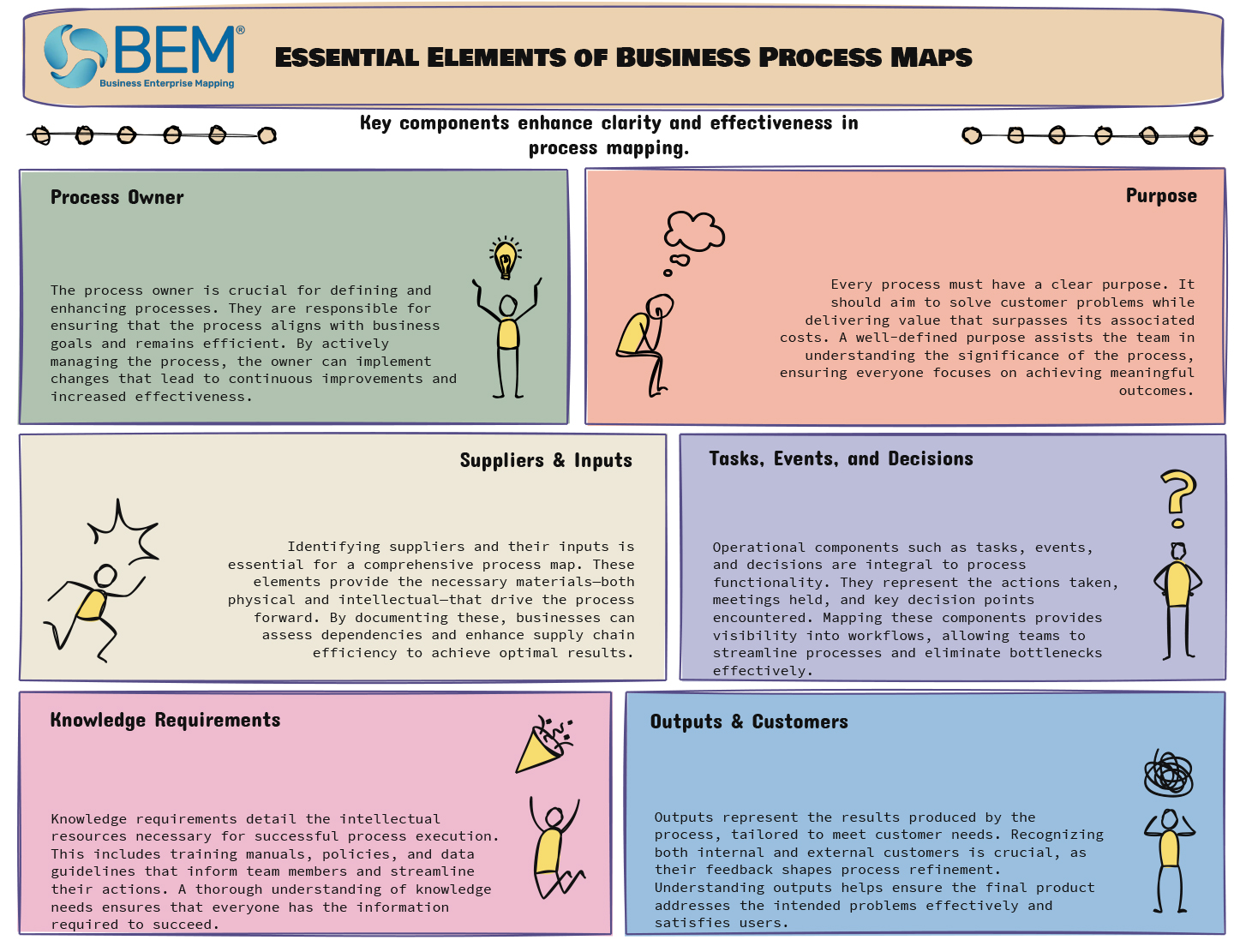If your goal is to truly understand how your business functions, investing in business process mapping (BPM) is a strategic move. BPM visually outlines how tasks flow through departments and across an organization, uncovering inefficiencies, best practices, and improvement opportunities. Whether you're aiming to enhance efficiency, ensure regulatory compliance, or integrate new technologies, BPM offers a pathway to align processes with organizational goals.
The Purposes and Goals of Business Process Mapping
At its core, business process mapping is versatile. Organizations apply it for multiple strategic reasons:
- Simplifying workflows for greater efficiency
- Standardizing processes to enable automation
- Optimizing product introduction through improved process flow
- Meeting regulatory compliance standards
- Supporting quality management systems
- Navigating mergers or acquisitions
The key to success lies in identifying where you want deeper insight or improvement. BPM allows you to analyze your organization's capabilities and performance across all functions.
Five Key Reasons to Implement Business Process Mapping
- Solving Problems
Leaders often sense inefficiencies but lack clarity on how to address them. Process maps provide a high-level overview that serves as a launching point for problem-solving. - Preparing for New Software Systems
Too often, businesses jump into implementing new systems without understanding their internal processes. Mapping out existing workflows before introducing new software avoids misalignment and wasted resources. - Documenting Business Operations
Especially in fast-growing companies, new processes emerge frequently. Process maps help standardize operations, create a foundation for regulatory compliance (e.g., ISO9001), and support long-term growth. - Improving the Business
Process maps are useful for understanding how departments interact. They support workflow analysis, employee training, onboarding, performance measurement, and continuous improvement. - Gaining Competitive Advantage
Best-in-class companies use BPM as a strategic tool to organize enterprise improvements and benchmark against competitors. Well-structured processes provide a foundation for sustainable success.
Regardless of the goal—whether general understanding or strategic advantage—business process mapping helps create value for customers and streamline internal workflows.
What Makes a Good Business Process Map?
While many companies attempt process mapping, the lack of a universal standard often leads to inconsistency. Business Enterprise Mapping (BEM) suggests every process map include the following key elements:
- Process Owner
This individual is accountable for defining and continuously improving the process. - Purpose
The process must solve customer problems and add more value than it costs. - Suppliers & Inputs
Suppliers provide the raw materials—physical or intellectual—that are transformed during the process. - Tasks, Events, and Decisions
These are the operational components of a process—actions, meetings, and decision points that lead to outputs. - Knowledge Requirements
Processes depend on intellectual resources like training manuals, policies, data, and standards. - Outputs & Customers
Outputs must solve problems for customers, who can be internal or external stakeholders. - Responsibilities (RACI Matrix)
Defines who is Responsible, Approves, Consults, and is Informed for each task, ensuring clear accountability. - Metrics
Effective process monitoring depends on meaningful metrics—such as efficiency, quality, and response times. - Opportunities
Mapping often uncovers 25–50 improvement opportunities per process, which should be visually identified in the map. - Connectivity
A good map shows how one process connects to others within the organization’s business system.
Together, these components make BPM a tool not just for visualization, but for sustainable performance improvement.
Elevating BPM: The Perigon Playbook Approach
While many organizations use BPM as a temporary tool during analysis or software implementation, the Perigon Playbook treats process maps as valuable, long-term organizational assets—essentially, the intellectual property that defines how a company operates.
The Perigon Playbook organizes process documentation into four main elements, structured like a book:
1. Process Scorecard (Book Cover)
Summarizes the purpose, performance metrics, process maturity, and key improvement opportunities.
2. Architecture Map (Table of Contents)
Provides an executive summary that highlights main inputs, outputs, suppliers, and customers, defining the backbone of the process.
3. Process Map (Book Contents)
Goes beyond a single diagram to include up to three process states:
- Current State: Details the existing workflow, identifying problems and opportunities.
- Near State: Represents improvements being implemented or in planning.
- Future State: Envisions a streamlined process using best practices and automation.
It also defines connectivity—how the process fits within broader organizational systems.
4. Process Knowledge (Appendix)
Captures the deep intellectual knowledge required to execute and improve the process. This includes:
- Customer Value Assessment: Understands quality, cost, and service expectations.
- Information Analysis: Details work instructions, specs, policies, etc.
- RACI Analysis: Clarifies role assignments.
- Value & Metrics Analysis: Evaluates task impact and identifies key performance indicators.
- Opportunity & Maturity Analysis: Prioritizes improvement areas and assesses readiness for change.
- Process Improvement Plan: Outlines the actions, owners, and timelines needed to enhance the process.
The Benefits of the Perigon Playbook
The Playbook isn’t just a documentation tool—it’s a strategic asset that:
- Enhances cross-functional alignment
- Embeds institutional knowledge
- Drives sustained process improvement
- Facilitates enterprise-level performance gains
By defining processes from multiple perspectives and embedding them into the company’s operational structure, the Perigon Playbook transforms BPM from a one-time activity into a living strategy.

Conclusion: BPM as a Competitive Enabler
Process maps are more than visual aids—they are the foundation of organizational performance. When used correctly, they offer powerful insights, uncover improvement opportunities, and help standardize and scale operations. The Perigon Playbook elevates this even further, turning BPM into an integrated, comprehensive system for enterprise success.
Businesses that embrace this holistic approach can achieve:
- Better decision-making
- Improved customer satisfaction
- Reduced waste and inefficiencies
- A stronger foundation for growth and innovation
In today’s fast-paced environment, those who know how their work gets done—and continuously improve it—will lead the way.

